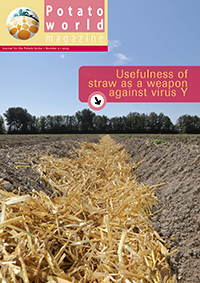Already a subscriber? Activate your premium account

Potatoworld Magazine

Powdery scab is a nasty seed-borne, soil-borne and even, through contaminated dust, air-borne potato disease. The culprit is Spongospora subterranea f. sp. subterranea (abbreviated as SSS), an obligate, parasitic plasmodiophorid with a wide host range. This parasite affects root systems, but also tubers. Moreover, it is the vector of the potato mop-top virus. From the Andes, it spread to most potato growing regions, especially in temperate zones. Its polycyclic life cycle, with an asexual and a sexual phase, and its robust resting spores make it difficult to control.
Germinating resting spores of SSS release zoospores, perhaps in response to potato root exudates, that move to tubers. Upon infection, zoospores form distinct raised lesions on the tuber skin. That is what we call powdery scab. These lesions can split open and release spore balls (the “powder”) into the soil, thus spreading the disease. Soil conditions, especially temperature and moisture, are crucial for the release, movement and pathogenicity of the zoospores. Tubers respond to infections by producing corky tissue to stop further disease development.
Recently, Strydom et al. published an impressive review paper in Potato Research. They reviewed the classification, genetics, and life cycle of SSS, the infection process and pathogenesis, the environmental factors affecting SSS, its detection and quantification, management options, and knowledge gaps. Let me highlight what they teach us on management options and knowledge gaps.
There is no single method available that can control the disease. But there is a wide range of practices that can contribute to an integrated approach, targeting resting spores, zoospores, soil and crop. Such an integrated approach should include strategies related to host resistance or tolerance, disease avoidance, soil treatment, and damage control through crop management.
A first strategy is selecting resistant or tolerant cultivars. However, there are no commercial cultivars available that are immune to SSS. Yet, available genetic variation in resistance and tolerance makes it possible to reduce both disease impact and inoculum accumulation over time. The related traits are polygenic. Breeding should focus on reducing the lesion formation on tubers and root infections. These reductions are not closely linked.
The second strategy is to avoid or escape the disease by selecting a disease-free field, with a soil that is not conducive to infection, combined with planting disease-free seed tubers. Planting at the right time can also help, given the sensitivity of the zoospores to soil conditions, aiming at relatively warm and dry conditions during tuber initiation and early tuber development.
The third strategy is to reduce initial inoculum in the soil, for example by wide crop rotation, adding organic soil amendments, applying soil fumigation or soil fungicides. However, because of the longevity of the spore balls, the wide host range and possible volunteer potatoes, crop rotation has only limited effect. Green manure, trap and biofumigant crops can be beneficial to some extent, but soil fumigation, if at all permitted, often has disappointing results. The same applies to soil fungicides.
The fourth strategy is implementing cultural practices that increase crop resistance or tolerance and reduce damage. This may include sanitation and hygiene, biological control, for example through organic amendments mimicking root exudates that trigger untimely germination of resting spores, application of inorganic and organic fertiliser, and irrigation management. In any case, soil conditions should be created that limit the ability of SSS to persist and infect.
However, these strategies require more knowledge: better understanding of the weaknesses of SSS, targets and mechanisms of plant tolerance and resistance, dynamics of SSS soil inoculum, the microbiology of soil suppressiveness, the impact of soil and crop management on beneficial soil microbiome, and of effects of fluctuating soil conditions on SSS, is required. ●

Prof. Dr. Paul Struik
Professor emeritus Wageningen
University & Research (WUR)
Reference
Strydom, R.F., Wilson, C.R., Tegg, R.S., Balendres, M.A. & van der Waals, J.E., 2024. Advancements in Spongospora subterranea: Current Knowledge, Management Strategies, and Research Gaps. Potato Research. https://doi.org/10.1007/s11540-024-09701-8
Events
©2015 - 2024 Potatoworld | Webdesign and realisation COMMPRO